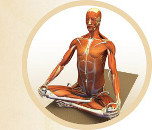


SUKHASANA
EASY CROSS-LEGGED POSE
Sukhasana is the seated position most commonly used in meditation. Accordingly, many of the other poses of Hatha Yoga are directed toward making it easier and more comfortable to sit for long periods in this pose. In fact, the Sanskrit word asana is often translated to mean “a comfortable and easy position.”
To sit comfortably in Sukhasana, we want to minimize the muscular effort required to be in the pose. One way to achieve this is by bringing the knees closer to the mat, thereby lowering the center of gravity toward the pelvic core. Do this by stretching the muscles that surround the hips, especially the adductors and internal rotators. This allows the femurs to abduct and externally rotate.
Align the vertebral column over the pelvis so that the weight of the trunk is supported by the skeleton (bones) instead of primarily by muscular contraction. This makes it possible to hold the pose with less effort. Use closed chain contraction of the latissimus dorsi to draw the torso forward so that the mechanical axis (the direction of gravity) and the anatomical axis of the vertebral column align with each other. Refine the pose by engaging the accessory muscles of breathing to expand the chest.
BASIC JOINT POSITIONS
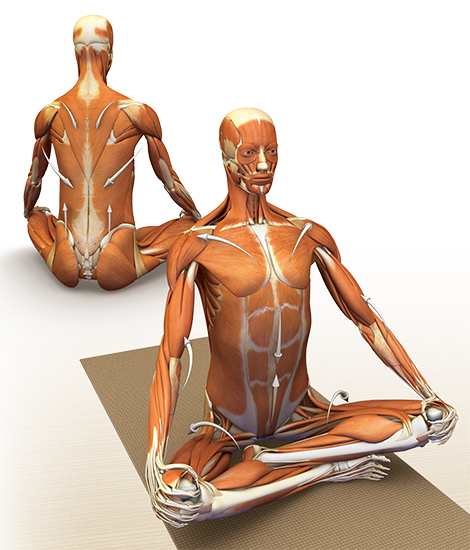
Stretch the adductor group on the insides of the thighs with poses such as Baddha Konasana and Upavistha Konasana. Use facilitated stretching to lengthen the internal rotators with the cradle stretch.
Lift the chest by fixing the hands on the knees and attempting to pull back. The arms will not move so the chest is drawn forward by closed chain contraction of the latissimus dorsi. This draws the vertebral column over the pelvis and expands the chest.
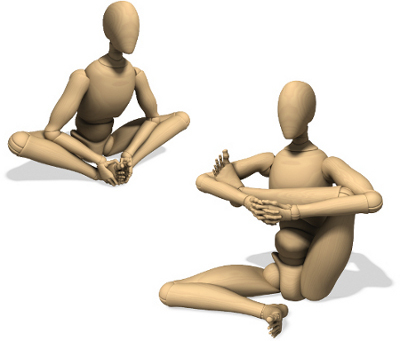


STEP 1 Activate the psoas muscles by pressing down on the knees while trying to lift them. This produces a closed chain contraction, whereby the origin of the psoas moves (not the insertion), lifting the lumbar and tilting the pelvis forward. This synergizes the action of the quadratus lumborum on the lumbar spine. Visualize the sartorius contracting to flex, abduct, and externally rotate the hips. This muscle also assists the psoas in tilting the pelvis forward.

STEP 2 Bend the knees by engaging the hamstrings. We relax these muscles once in the pose but occasionally return to them to refine the position of the legs and re-establish congruency of the knee joints.
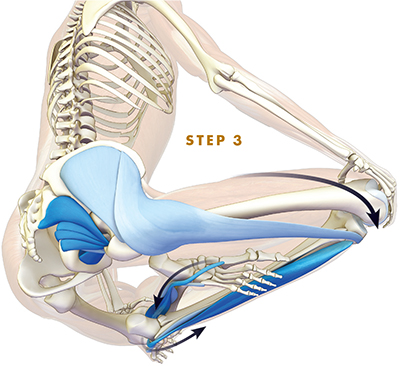
STEP 3 The tensor fascia lata and gluteus medius activate to abduct the thighs toward the floor. Note that these muscles are internal rotators of the hips. Sukhasana externally rotates the hips. Accordingly, prepare for the pose by stretching the tensor fascia lata and gluteus medius to lengthen their internal rotation components. Then engage the same muscles to abduct the hips.
Tuck the tailbone while turning the thighs outward to engage the deep external hip rotators. Refine the pose by gently pressing the outer edges of the feet into the mat. This activates the peroneus longus and brevis muscles at the sides of the lower legs.
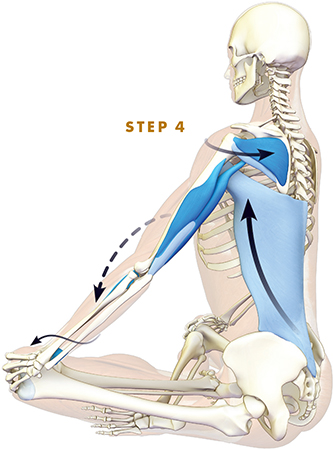
STEP 4 Place the hands on the knees and pronate the forearms to turn the palms down, engaging the pronators teres and quadratus. Contract the triceps to attempt to straighten the elbows. Engage the infraspinatus and teres minor muscles to externally rotate the shoulders. The posterior deltoids synergize this action. Then pull with the hands to draw the chest forward, activating the latissimus dorsi in a closed chain fashion, as shown.
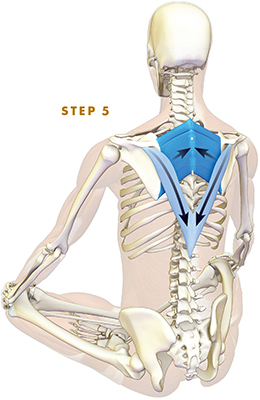
STEP 5 Draw the shoulder blades toward the midline by contracting the rhomboids. This opens the chest and stabilizes the scapulae in place, preparing for Step 6. Activate the lower third of the trapezius to draw the shoulder blades down the back.
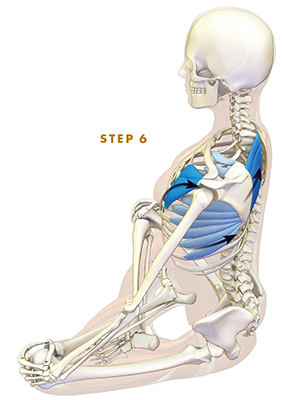
STEP 6 Stabilize the scapulae toward the midline of the back. Then lift the ribcage by engaging the pectoralis minor. The cue for activating this muscle is to attempt to roll the shoulders forward. Because the shoulders are fixed in place by the rhomboids, they will not actually roll forward. Instead, the contraction of the pectoralis minor lifts the ribs and opens the chest.
Expand the chest further by engaging the serratus anterior. Note how this muscle also originates from the scapula and attaches to the ribs (like the pectoralis minor). Accordingly, when the scapulae are tethered in place by the rhomboids, engaging the serratus anterior lifts and expands the chest. The cue for contracting this muscle is to visualize pressing the hands outward against a door frame.